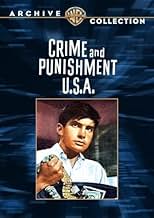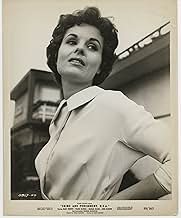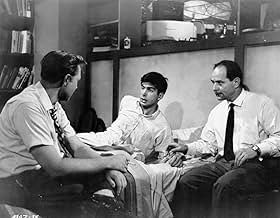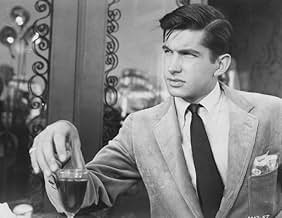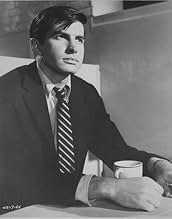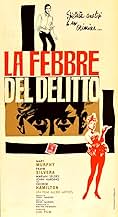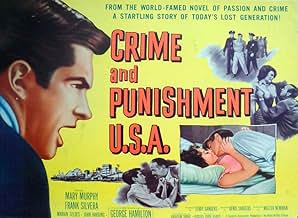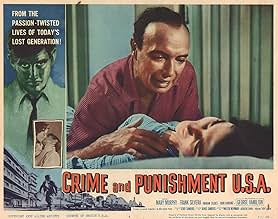A Californian law student murders a pawnbroker, then matches wits with the detective on the case.A Californian law student murders a pawnbroker, then matches wits with the detective on the case.A Californian law student murders a pawnbroker, then matches wits with the detective on the case.
- Director
- Writers
- Stars
- Nominated for 1 BAFTA Award
- 2 wins & 1 nomination total
Tony Johnson
- Mrs. Cole
- (as Toni Merrill)
Sidney Clute
- Doctor
- (as Sid Clute)
James Hyland
- Man in Coffee Shop
- (as Jim Hyland)
- Director
- Writers
- All cast & crew
- Production, box office & more at IMDbPro
Featured reviews
To begin with, I almost did not acquire this when I chanced upon it, since the film does not have much of a reputation; even so, it has recently been released on DVD-R as part of Warners' "Archive Collection", running 96 minutes (like the version I watched) rather than 78 as listed on the IMDb! In any case, the result is undeniably gripping (given the source material) and decidedly accomplished (in spite of the obvious low budget) – with gleaming cinematography by Floyd Crosby and a jazzy score by Herschel Burke Gilbert.
Best of all, the performances (notably, as always, the arrogant protagonist and his wily nemesis) are reasonably impressive. George Hamilton (being nominated for a BAFTA award in his film debut) kind of channels Anthony Perkins here, and it is unfortunate that he would soon forsake such thoughtful roles for sophisticated (and, in the long run, superficial) ones. Frank Silvera plays his pivotal cop role as something of a buffoon; Mary Murphy's character, then, does not shy away from discussing her sordid 'profession'; while John Harding appears as the seducer of the hero's sister. Incidentally, Hamilton's scenes with the latter two are only slightly less compelling than his confrontations with Silvera (established in previous cinematic renditions as the novel's centerpiece).
As the title suggests, Dostoyevsky's morality tale has been updated to modern-day America: curiously, it eschews the pivotal figure of the pawnbroker entirely (though we are still told why the murder was committed) – indeed, the narrative here starts off with the arrest of the painter! Still, the victim's essentially disagreeable characteristics are transferred onto the afore-mentioned Harding – which seemed unnecessary at first, but this does generate an intriguing complicity between the two murderers paid off, most effectively, in ironical fashion when the student ultimately confesses because he believes the other fellow killed himself out of remorse when it was over rejection!
In the end, the film is pretentious (boasting a powerful script by Walter Newman), with a tendency towards sleaze; that said, this mature approach is quite redolent of the transitional period in which it was made – being entrenched somewhere between studio-system Hollywood and the 'movie brats' generation. For the record, this was also director Sanders' first effort, of whose later work I have watched (and own) WAR HUNT (1962), ELVIS: THAT'S THE WAY IT IS (1970/2000) and INVASION OF THE BEE GIRLS (1973); besides, I have just acquired THE American WEST OF JOHN FORD (1971; TV) and am interested in ONE MAN'S WAY and SHOCK TREATMENT (both 1964).
Best of all, the performances (notably, as always, the arrogant protagonist and his wily nemesis) are reasonably impressive. George Hamilton (being nominated for a BAFTA award in his film debut) kind of channels Anthony Perkins here, and it is unfortunate that he would soon forsake such thoughtful roles for sophisticated (and, in the long run, superficial) ones. Frank Silvera plays his pivotal cop role as something of a buffoon; Mary Murphy's character, then, does not shy away from discussing her sordid 'profession'; while John Harding appears as the seducer of the hero's sister. Incidentally, Hamilton's scenes with the latter two are only slightly less compelling than his confrontations with Silvera (established in previous cinematic renditions as the novel's centerpiece).
As the title suggests, Dostoyevsky's morality tale has been updated to modern-day America: curiously, it eschews the pivotal figure of the pawnbroker entirely (though we are still told why the murder was committed) – indeed, the narrative here starts off with the arrest of the painter! Still, the victim's essentially disagreeable characteristics are transferred onto the afore-mentioned Harding – which seemed unnecessary at first, but this does generate an intriguing complicity between the two murderers paid off, most effectively, in ironical fashion when the student ultimately confesses because he believes the other fellow killed himself out of remorse when it was over rejection!
In the end, the film is pretentious (boasting a powerful script by Walter Newman), with a tendency towards sleaze; that said, this mature approach is quite redolent of the transitional period in which it was made – being entrenched somewhere between studio-system Hollywood and the 'movie brats' generation. For the record, this was also director Sanders' first effort, of whose later work I have watched (and own) WAR HUNT (1962), ELVIS: THAT'S THE WAY IT IS (1970/2000) and INVASION OF THE BEE GIRLS (1973); besides, I have just acquired THE American WEST OF JOHN FORD (1971; TV) and am interested in ONE MAN'S WAY and SHOCK TREATMENT (both 1964).
A young man murders an old woman for money, then relies on a sense of intellectual superiority to defeat an investigating detective.
A heavyweight subject like Dostoevski would be a challenge for the most experienced filmmaker. For the youthful crew here, however, it proves way too much. For one, Hamilton simply doesn't have the gravitas to bring off a convincing intellectual heavyweight, and that punches a hole right through the film's middle. But he's not the only one. Silvera's cagey detective makes those cat and mouse sessions with Robert (Hamilton) borderline parody. I don't know what director Sanders was telling him, but whatever it was, it didn't work. Ditto Harding's hammy wife killer that produces another regrettable result. Unfortunately, acting here means more than usual since there's so much loaded conversation. Only the two women, Murphy and Seldes, come off aptly.
On the other hand, the filmmakers certainly don't lack imagination. Adapting a bleak 19th- century Russian novel to the sunny climes of LA amounts to an imaginative undertaking, whatever the outcome. However, modifying a dense 1,000-page novel into a 70-minute screenplay would be a challenge for Dostoevski himself. Unfortunately, the effort here is like trying to pack 10 lbs. of weighty story into a 5 lb. leaky screenplay. All in all, I'm glad the Sanders brothers and Hamilton went on to more appropriate projects.
A heavyweight subject like Dostoevski would be a challenge for the most experienced filmmaker. For the youthful crew here, however, it proves way too much. For one, Hamilton simply doesn't have the gravitas to bring off a convincing intellectual heavyweight, and that punches a hole right through the film's middle. But he's not the only one. Silvera's cagey detective makes those cat and mouse sessions with Robert (Hamilton) borderline parody. I don't know what director Sanders was telling him, but whatever it was, it didn't work. Ditto Harding's hammy wife killer that produces another regrettable result. Unfortunately, acting here means more than usual since there's so much loaded conversation. Only the two women, Murphy and Seldes, come off aptly.
On the other hand, the filmmakers certainly don't lack imagination. Adapting a bleak 19th- century Russian novel to the sunny climes of LA amounts to an imaginative undertaking, whatever the outcome. However, modifying a dense 1,000-page novel into a 70-minute screenplay would be a challenge for Dostoevski himself. Unfortunately, the effort here is like trying to pack 10 lbs. of weighty story into a 5 lb. leaky screenplay. All in all, I'm glad the Sanders brothers and Hamilton went on to more appropriate projects.
In California, Robert Cole (George Hamilton) collapses in front of the cops. He buries the evidence of his crime, but a dying man may have seen him. He takes the man back home to Sally. He had written an article stating that certain superior people can break the law which comes to the notice of the police. He is brought in for an interview.
This opens on Pacific Ocean Park in Santa Monica. The most fascinating part of this B-crime movie may be the locations. It's great to see the old California with all the oil rigs. It does have a young George Hamilton as the lead. He's fine, but he's never been a great actor. I wanted this to start as a darker noir crime thriller. Robert should leave the man to die on the side of the road. That's the darker start. It's interesting that Robert has his views. Otherwise, the plot drags and I don't really care about him. This is not as compelling as it should be.
This opens on Pacific Ocean Park in Santa Monica. The most fascinating part of this B-crime movie may be the locations. It's great to see the old California with all the oil rigs. It does have a young George Hamilton as the lead. He's fine, but he's never been a great actor. I wanted this to start as a darker noir crime thriller. Robert should leave the man to die on the side of the road. That's the darker start. It's interesting that Robert has his views. Otherwise, the plot drags and I don't really care about him. This is not as compelling as it should be.
This is a very good adaptation of Dostoevsky's novel. The actors all gave solid performances, and the script captures the essence of an investigation into a crime that will depend on not on physical evidence, or finding a witness, but on a psychological campaign by the police detective, as he seeks to get a crack his suspect. As George Hamilton's Robert fences with Frank Silvera's Inspector Porter, he tries to come to terms with his own guilt and fear. In the end, it resolves wonderfully, with Robert coming to terms with his actions and deciding how to live them.
The low budget for the film seems to have been a benefit in this case. The seedy Southern California landscapes give a feel of desperation that makes the initial crime believable, and makes Robert's desire to escape it understandable. And the 'cheapness' fits the small cast, and the film's concentration on a few characters, intensifying the psychological pressure Robert is feeling.
Really well done, and I highly recommend it.
The low budget for the film seems to have been a benefit in this case. The seedy Southern California landscapes give a feel of desperation that makes the initial crime believable, and makes Robert's desire to escape it understandable. And the 'cheapness' fits the small cast, and the film's concentration on a few characters, intensifying the psychological pressure Robert is feeling.
Really well done, and I highly recommend it.
This is a well written script based on Dostoyevsky's "Crime and Punishment." I think it is essentially a remake of a French film, with Jean Gabin,called "Crime and Punishment," later changed to "The Most Dangerous Sin," made around the same time. At any rate, self- justification, remorse, rationalization, guilt, and Truth are the subjects at hand. Each is handled slowly, without emphasis; the viewer is expected to bring much to the picture. This explains the films lower ratings. Hamilton, as an actor, is weak, others have been reminded of Tony Perkins. He was too handsome, and wasn't smart enough to use make up or a cheap haircut to make himself appear to be the poor student of his role. But, the real star is Frank Silvera, who underplays the cagey Detective, and is a joy to watch in action. He toys with Hamilton, who, unfortunately, just isn't his match (as an actor.) Marian Seldes plays Hamilton's long suffering sister.
Did you know
- TriviaThe opening aerial shots are of Pacific Ocean Park in Santa Monica, CA, a popular amusement park in the 1960s that has since closed down.
- ConnectionsReferenced in Hollywood Mouth 3 (2018)
Details
- Runtime
- 1h 36m(96 min)
- Color
- Sound mix
Contribute to this page
Suggest an edit or add missing content

